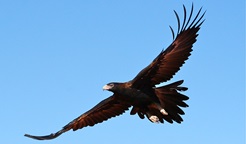Selwyn area
Kosciuszko National Park
Learn more
Learn more about why this area is special
Selwyn area is in Kosciuszko National Park. Here are just some of the reasons why this area is special:
Kiandra's claims to fame

The discovery of gold at Kiandra in 1859 attracted up to 10,000 prospectors hoping to strike it rich. Just 18 months later, after harsh winters and falling gold finds, only a few hundred gold miners remained. It's remembered as one of Australia’s shortest gold rushes, not to mention it’s highest (and coldest). In 1861, Kiandra became the birthplace of skiing in Australia, when Norwegian gold miners fashioned skis from fence palings. By the 1870s regular ski carnivals were arranged, and Australia had its first official ski slope here. Mining continued into the 1930s, with grazing and winter skiing also keeping the community alive. Before devastating fires in 2019-2020, four buildings still stood here, including Kiandra Courthouse, which had served as a courthouse, private residence, ski chalet, hotel and bar.
Plants and animals protected in this park
Animals
-

Bare-nosed wombat (Vombatus ursinus)
A large, squat marsupial, the Australian bare-nosed wombat is a burrowing mammal found in coastal forests and mountain ranges across NSW and Victoria. The only other remaining species of wombat in NSW, the endangered southern hairy-nosed wombat, was considered extinct until relatively recently.
-

Platypus (Ornithorhynchus anatinus)
One of the most fascinating and unusual Australian animals, the duck-billed platypus, along with the echidna, are the only known monotremes, or egg-laying mammals, in existence. The platypus is generally found in permanent river systems and lakes in southern and eastern NSW and east and west of the Great Dividing Range.
-

Wedge-tailed eagle (Aquila audax)
With a wingspan of up to 2.5m, the wedge-tailed eagle is Australia’s largest bird of prey. These Australian animals are found in woodlands across NSW, and have the ability to soar to heights of over 2km. If you’re bird watching, look out for the distinctive diamond-shaped tail of the eagle.
Plants
-

Billy buttons (Craspedia spp. )
Billy buttons are attractive Australian native plants that are widespread throughout eastern NSW in dry forest, grassland and alpine regions such as Kosciuszko National Park. The golden-yellow globe-shaped flowers are also known as woollyheads. Related to the daisy, billy buttons are an erect herb growing to a height of 50cm.
Look out for...
Wedge-tailed eagle
Aquila audax

With a wingspan of up to 2.5m, the wedge-tailed eagle is Australia’s largest bird of prey. These Australian animals are found in woodlands across NSW, and have the ability to soar to heights of over 2km. If you’re bird watching, look out for the distinctive diamond-shaped tail of the eagle.
